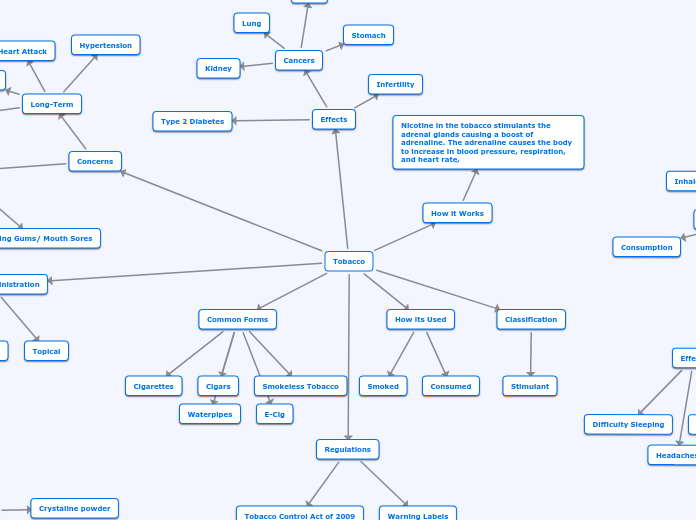Tobacco
Common Forms
Cigarettes
Cigars
Smokeless Tobacco
Waterpipes
E-Cig
How its Used
Smoked
Consumed
Classification
Stimulant
Regulations
Tobacco Control Act of 2009
Warning Labels
How it Works
Nicotine in the tobacco stimulants the adrenal glands causing a boost of adrenaline. The adrenaline causes the body to increase in blood pressure, respiration, and heart rate,
Effects
Cancers
Head
Lung
Stomach
Kidney
Type 2 Diabetes
Infertility
Concerns
Long-Term
Hypertension
Heart Attack
Lung Cancer
Menstrual Disorder
Short-Term
Yellow Teeth
Bad Breath
Receding Gums/ Mouth Sores
Sensitive Teeth
Routes of Administration
Oral
Inhalant
Topical
Intranasal Insufflation
Caffeine
Common Forms
Food
Beverage
Pain Relievers
How it Works
Caffeine is absorbed into the blood and body tissues. Works by stimulating the brain.
How it is Used
Restore mental alertness during fatigue, found in headache medications.
Classification
Stimulant
Regulations
GRAS
Effects
Difficulty Sleeping
Anxiety
Diarrhea
Headaches
Chest Pain
Concerns
Short-Term
Heart Rate
Alertness
Blood Pressure
Long-Term
Difficulty Sleeping
Weakness
Tremors
Routes of Administration
Injection
Consumption
Inhalent
Meth
Concerns
Short-Term
Disturbed sleep patterns
Hyperactivity
Paranoia
Nausea
Long-Term
Decreased hunger
Brain damage
Increased blood pressure
Increased heart rate
How it's used
Consumed
Snorted
Hooping/Rectum
Smoked
Injected
Routes of Administration
Oral
Injection
Inhalant
Effects
Alertness
Energetic
Hallucinations
How it Works
Meth works by flooding the brain with dopamine (pleasure). Also forcing neurons to release noradrenaline. Causing people to feel energetic, awake, and alert. The power of euphoric effects is a major reason why people can become dependent on meth so quickly.
Regulations
Schedule 2 controlled substances act
Common Forms
Crystaline powder
Crystals
Base-oily substance
Classification
Stimulant
Benzodiazepine/Valium
Routes of Admission
Consumed
Concerns
Short-Term
Diarrhea
Constipation
Dizziness
Nausea
Long-Term
Irregular Heartbeat
Tremors
Seizers
Sleeping Problems
Effects
Drowsiness
Dizziness
Constipation
Regulations
Black box warning
How it Works
Works with the chemicals in the brain called GABA. GABA reduces activity in parts of the brain that control memory, emotions, logical thoughts, and functions like breathing. Valium increases effects of GABA. Makes muscles relax, reduce anxiety, and causes drowsiness.
Common Forms
Oral Tablet
Oral solution
Rectal gel
How it's Used
Consumed
Classification
Depressant
opioids
Common Forms
Pain Reliever
Synthetic opioids
Prescription Pill
How it's Used
oral consumption
Prescription use
Classification
Stimulant
Depressant
Effects
Dizziness
Nausea
Vomiting
Constipation
Tolerance
Concerns
Short-Term
Drowsiness
Slowed breathing
Constipation
Nausea
Long-Term
Physical Dependence
Muscle/Bone Pain
Insomnia
Tolerance
Routes of Administration
Oral
Enternal tubes
Injection
transdermal
Regulations
Federal controlled substances law legalizes the essential medical value of many drugs that are controlled substances. FDA requires safety labels for opioid pain medication
How it Works
Opioids attach to proteins called opioid receptors on nerve cells in the brain, spine and other parts of the body. The opioids block pain messages sent from the body through the spine to the brain.
Psychedelics
Common Forms
Blotting Paper
Tablets
Powder
How it's Used
Smoking
Snorting
Sublingual
Injected
Brewed
Consumed
Classification
Hallucinogen
Effects
Emotions
Sleep
Hunger
Pain Perception
Concerns
Short-Term
Increased Heart Beat
Nausea
Intensified sensory
Long-Term
Anxiety
Weight Loss
Memory Loss
Depression
Routes of Administration
Oral
Injection
Inhalant
Sublingual
Regulations
Declared illegal under the unconventional on psychotropic substances of 1971. Many countries have analogue acts that automatically forbid any drugs sharing similar chemical structures to common illicit substances regardless of whether or not they are harmful.
How it Works
Temporarily disrupt the communication between brain chemical systems throughout the brain and spinal cord. Some psychedelics interfere with the action of the brain chemical serotonin which then effects a persons mood, sleep, hunger, and body temperature.
